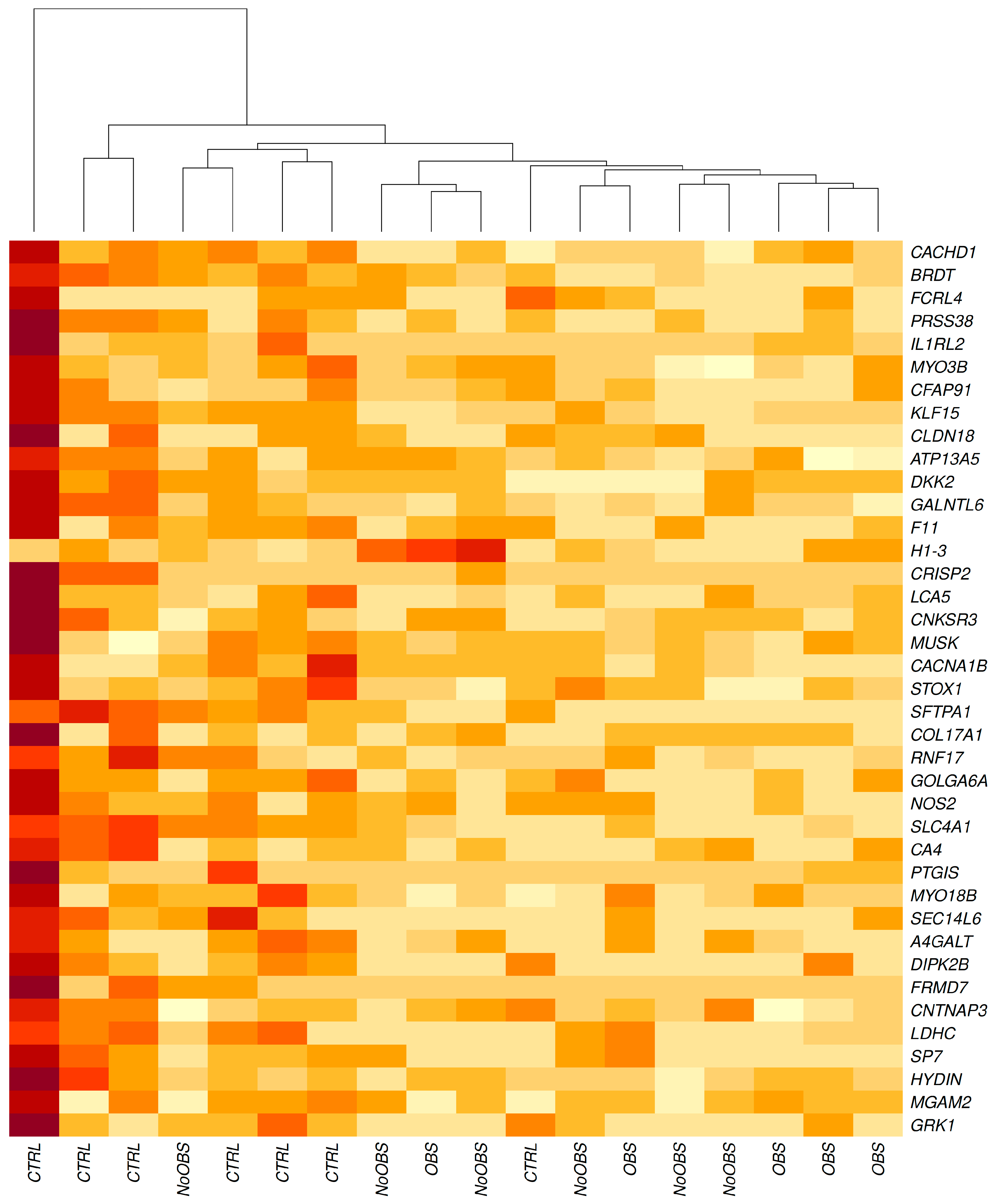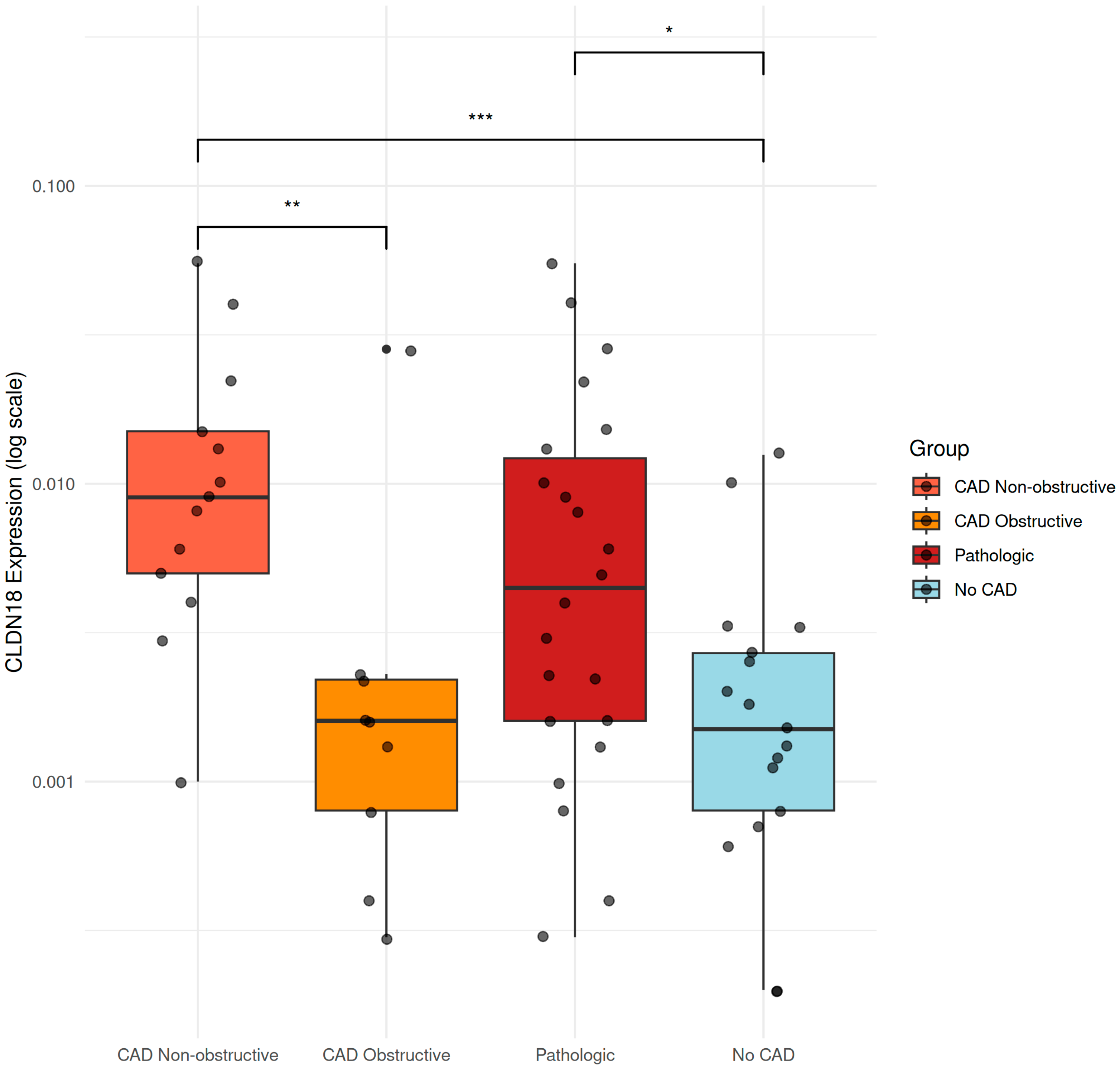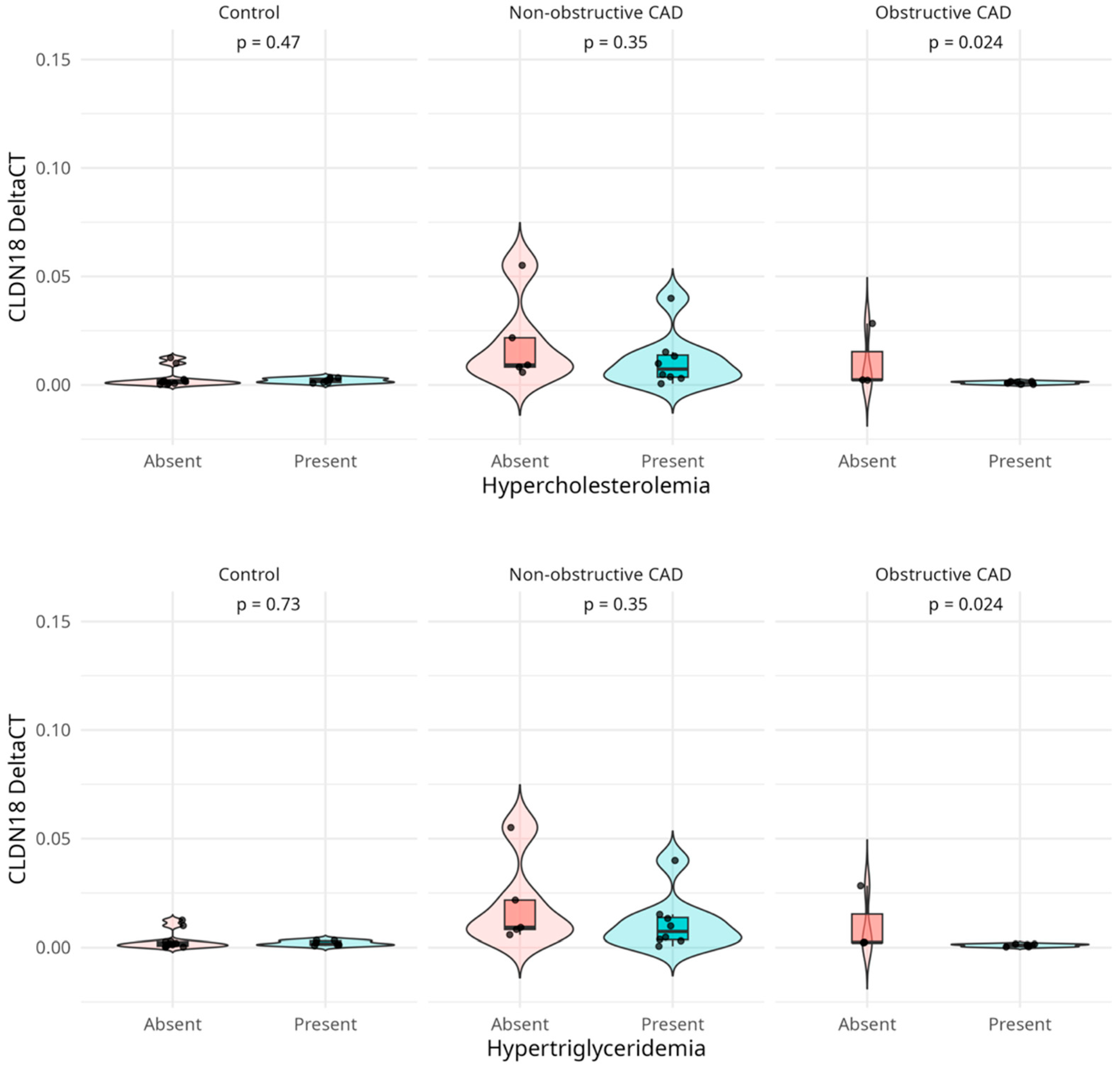Integrative Transcriptomic and Epigenomic Profiling for Signature Identification in Coronary Artery Disease: A Pilot Study
Abstract
1. Introduction
2. Results
2.1. Clinical Features of the Study Population
2.2. Omics Data Characterisation
2.3. Omics Data Validation
2.4. Functional Analysis
3. Discussion
4. Materials and Methods
4.1. Study Population
4.2. Imaging Protocol and Analysis
4.3. PBMC Isolation
4.4. RNA Isolation
4.5. cDNA Synthesis and Real-Time Quantitative PCR
4.6. Fast-ATAC Sequencing
4.7. RNA-Seq Analysis and Chromatin State Analysis
4.8. ATAC-Seq Analysis
4.9. Statistical Analysis
5. Conclusions
Supplementary Materials
Author Contributions
Funding
Institutional Review Board Statement
Informed Consent Statement
Data Availability Statement
Conflicts of Interest
References
- Virani, S.S.; Alonso, A.; Aparicio, H.J.; Benjamin, E.J.; Bittencourt, M.S.; Callaway, C.W.; Carson, A.P.; Chamberlain, A.M.; Cheng, S.; Delling, F.N.; et al. Heart Disease and Stroke Statistics—2021 Update: A Report From the American Heart Association. Circulation 2021, 143, e254–e743. [Google Scholar] [CrossRef]
- Roth, G.A.; Mensah, G.A.; Johnson, C.O.; Addolorato, G.; Ammirati, E.; Baddour, L.M.; Barengo, N.C.; Beaton, A.Z.; Benjamin, E.J.; Benziger, C.P.; et al. Global Burden of Cardiovascular Diseases and Risk Factors, 1990–2019: Update From the GBD 2019 Study. J. Am. Coll. Cardiol. 2020, 76, 2982–3021. [Google Scholar] [CrossRef]
- Bentzon, J.F.; Otsuka, F.; Virmani, R.; Falk, E. Mechanisms of Plaque Formation and Rupture. Circ. Res. 2014, 114, 1852–1866. [Google Scholar] [CrossRef]
- Hayden, M.R. Peripheral Artery Disease: Atherosclerosis, Decreased Nitric Oxide, and Vascular Arterial Stiffening. J. Vasc. Dis. 2025, 4, 21. [Google Scholar] [CrossRef]
- Bottardi, A.; Prado, G.F.A.; Lunardi, M.; Fezzi, S.; Pesarini, G.; Tavella, D.; Scarsini, R.; Ribichini, F. Clinical Updates in Coronary Artery Disease: A Comprehensive Review. J. Clin. Med. 2024, 13, 4600. [Google Scholar] [CrossRef] [PubMed]
- Björkegren, J.L.M.; Lusis, A.J. Atherosclerosis: Recent developments. Cell 2022, 185, 1630–1645. [Google Scholar] [CrossRef]
- Rizzacasa, B.; Amati, F.; Romeo, F.; Novelli, G.; Mehta, J.L. Epigenetic Modification in Coronary Atherosclerosis. J. Am. Coll. Cardiol. 2019, 74, 1352–1365. [Google Scholar] [CrossRef] [PubMed]
- Khan, A.W.; Paneni, F.; Jandeleit-Dahm, K.A.M. Cell-specific epigenetic changes in atherosclerosis. Clin. Sci. Lond. Engl. 1979, 135, 1165–1187. [Google Scholar] [CrossRef] [PubMed]
- Sum, H.; Brewer, A.C. Epigenetic modifications as therapeutic targets in atherosclerosis: A focus on DNA methylation and non-coding RNAs. Front. Cardiovasc. Med. 2023, 10, 1183181. [Google Scholar] [CrossRef]
- Tang, H.; Zeng, Z.; Shang, C.; Li, Q.; Liu, J. Epigenetic Regulation in Pathology of Atherosclerosis: A Novel Perspective. Front. Genet. 2021, 12, 810689. [Google Scholar] [CrossRef]
- Khyzha, N.; Alizada, A.; Wilson, M.D.; Fish, J.E. Epigenetics of Atherosclerosis: Emerging Mechanisms and Methods. Trends Mol. Med. 2017, 23, 332–437. [Google Scholar] [CrossRef] [PubMed]
- Borck, P.C.; Guo, L.W.; Plutzky, J. BET Epigenetic Reader Proteins in Cardiovascular Transcriptional Programs. Circ. Res. 2020, 126, 1190–1208. [Google Scholar] [CrossRef]
- Jaenisch, R.; Bird, A. Epigenetic regulation of gene expression: How the genome integrates intrinsic and environmental signals. Nat. Genet. 2003, 33, 245–254. [Google Scholar] [CrossRef]
- Gorabi, A.M.; Penson, P.E.; Banach, M.; Motallebnezhad, M.; Jamialahmadi, T.; Sahebkar, A. Epigenetic control of atherosclerosis via DNA methylation: A new therapeutic target? Life Sci. 2020, 253, 117682. [Google Scholar] [CrossRef]
- Kuznetsova, T.; Prange, K.H.M.; Glass, C.K.; De Winther, M.P.J. Transcriptional and epigenetic regulation of macrophages in atherosclerosis. Nat. Rev. Cardiol. 2020, 17, 216–228. [Google Scholar] [CrossRef]
- Aziz, M.; Jandeleit-Dahm KAm Khan, A.W. Interplay between epigenetic mechanisms and transcription factors in atherosclerosis. Atherosclerosis 2024, 395, 117615. [Google Scholar] [CrossRef]
- Zhu, X.; Chen, Z.; Shen, W.; Huang, G.; Sedivy, J.M.; Wang, H.; Ju, Z. Inflammation, epigenetics, and metabolism converge to cell senescence and ageing: The regulation and intervention. Signal Transduct. Target. Ther. 2021, 6, 245. [Google Scholar] [CrossRef] [PubMed]
- Xu, H.; Li, S.; Liu, Y.S. Roles and Mechanisms of DNA Methylation in Vascular Aging and Related Diseases. Front. Cell Dev. Biol. 2021, 9, 699374. [Google Scholar] [CrossRef] [PubMed]
- Dunn, J.; Thabet, S.; Jo, H. Flow-Dependent Epigenetic DNA Methylation in Endothelial Gene Expression and Atherosclerosis. Arter. Thromb. Vasc. Biol. 2015, 35, 1562–1569. [Google Scholar] [CrossRef]
- Wu, X.; Zhang, H. Omics Approaches Unveiling the Biology of Human Atherosclerotic Plaques. Am. J. Pathol. 2024, 194, 482–498. [Google Scholar] [CrossRef]
- Döring, Y.; Noels, H.; Weber, C. The Use of High-Throughput Technologies to Investigate Vascular Inflammation and Atherosclerosis. Arter. Thromb. Vasc. Biol. 2012, 32, 182–195. [Google Scholar] [CrossRef]
- Doherty, T.M.; Uzui, H.; Fitzpatrick, L.A.; Tripathi, P.V.; Dunstan, C.R.; Asotra, K.; Rajavashisth, T.B. Rationale for the role of osteoclast-like cells in arterial calcification. FASEB J. 2002, 16, 577–582. [Google Scholar] [CrossRef]
- Hewitt, K.J.; Agarwal, R.; Morin, P.J. The claudin gene family: Expression in normal and neoplastic tissues. BMC Cancer 2006, 6, 186. [Google Scholar] [CrossRef]
- Xu, S. Transcriptome Profiling in Systems Vascular Medicine. Front. Pharmacol. 2017, 8, 563. [Google Scholar] [CrossRef]
- Grandi, F.C.; Modi, H.; Kampman, L.; Corces, M.R. Chromatin accessibility profiling by ATAC-seq. Nat. Protoc. 2022, 17, 1518–1552. [Google Scholar] [CrossRef] [PubMed]
- Akbari, T.; Fard, T.K.; Fadaei, R.; Rostami, R.; Moradi, N.; Movahedi, M.; Fallah, S. Evaluation of MMP-9, IL-6, TNF-α levels and peripheral blood mononuclear cells genes expression of MMP-9 and TIMP-1 in Iranian patients with coronary artery disease. J. Cardiovasc. Thorac. Res. 2023, 15, 223–230. [Google Scholar] [CrossRef]
- Zhong, J.; Agha, G.; Baccarelli, A.A. The Role of DNA Methylation in Cardiovascular Risk and Disease: Methodological Aspects, Study Design, and Data Analysis for Epidemiological Studies. Circ. Res. 2016, 118, 119–131. [Google Scholar] [CrossRef] [PubMed]
- Amrute, J.M.; Lee, P.C.; Eres, I.; Lee, C.J.M.; Bredemeyer, A.; Sheth, M.U.; Yamawaki, T.; Gurung, R.; Anene-Nzelu, C.; Qiu, W.-L.; et al. Single cell variant to enhancer to gene map for coronary artery disease. medRxiv 2024. preprint. [Google Scholar] [CrossRef] [PubMed]
- Zhao, Y.F.; Zuo, Z.A.; Li, Z.Y.; Hong, S.C.; Fu, W.G.; Zhou, B.; Wang, L.X. Integrated multi-omics profiling reveals neutrophil extracellular traps potentiate Aortic dissection progression. Nat. Commun. 2024, 15, 10736. [Google Scholar] [CrossRef]
- Furuse, M.; Fujita, K.; Hiiragi, T.; Fujimoto, K.; Tsukita, S. Claudin–1 and–2: Novel Integral Membrane Proteins Localizing at Tight Junctions with No Sequence Similarity to Occludin. J. Cell Biol. 1998, 141, 1539–1550. [Google Scholar] [CrossRef]
- Li, Y.; Jiang, D.; Zhang, Z.X.; Zhang, J.J.; He, H.Y.; Liu, J.L.; Wang, T.; Yang, X.X.; Liu, B.D.; Yang, L.L.; et al. Colorectal cancer cell-secreted exosomal miRNA N-72 promotes tumor angiogenesis by targeting CLDN18. Am. J. Cancer Res. 2023, 13, 3482–3499. [Google Scholar] [PubMed]
- Türeci, Ö.; Koslowski, M.; Helftenbein, G.; Castle, J.; Rohde, C.; Dhaene, K.; Seitz, G.; Sahin, U. Claudin-18 gene structure, regulation, and expression is evolutionary conserved in mammals. Gene 2011, 481, 83–92. [Google Scholar] [CrossRef] [PubMed]
- Zanoli, L.; Briet, M.; Empana, J.P.; Cunha, P.G.; Mäki-Petäjä, K.M.; Protogerou, A.D.; Tedgui, A.; Touyz, R.M.; Schiffrin, E.L.; Spronck, B.; et al. Vascular consequences of inflammation: A position statement from the ESH Working Group on Vascular Structure and Function and the ARTERY Society. J. Hypertens. 2020, 38, 1682–1698. [Google Scholar] [CrossRef]
- Wolf, D.; Ley, K. Immunity and Inflammation in Atherosclerosis. Circ. Res. 2019, 124, 315–327. [Google Scholar] [CrossRef]
- Gordon, D.; Reidy, M.A.; Benditt, E.P.; Schwartz, S.M. Cell proliferation in human coronary arteries. Proc. Natl. Acad. Sci. USA 1990, 87, 4600–4604. [Google Scholar] [CrossRef]
- Krause, G.; Winkler, L.; Mueller, S.L.; Haseloff, R.F.; Piontek, J.; Blasig, I.E. Structure and function of claudins. Biochim. Biophys. Acta BBA Biomembr. 2008, 1778, 631–645. [Google Scholar] [CrossRef]
- Favero, G.; Paganelli, C.; Buffoli, B.; Rodella, L.F.; Rezzani, R. Endothelium and its alterations in cardiovascular diseases: Life style intervention. BioMed. Res. Int. 2014, 2014, 801896. [Google Scholar] [CrossRef]
- Angelow, S.; Yu, A.S.L. Structure-Function Studies of Claudin Extracellular Domains by Cysteine-scanning Mutagenesis. J. Biol. Chem. 2009, 284, 29205–29227. [Google Scholar] [CrossRef]
- Nepali, S.; Chen, M.; Karthikeyan, B.; Sonkawade, S.D.; Mahajan, S.D.; Spernyak, J.; Sharma, U.C.; Pokharel, S. Claudin 1 dysregulation disrupts coronary microvascular integrity and impairs cardiac function. Atherosclerosis 2025, 403, 119149. [Google Scholar] [CrossRef]
- Ji, W.; Zhuang, X.; Jiang, W.G.; Martin, T.A. Tight junctional protein family, Claudins in cancer and cancer metastasis. Front. Oncol. 2025, 15, 1596460. [Google Scholar] [CrossRef] [PubMed] [PubMed Central]
- González-Mariscal, L.; Betanzos, A.; Nava, P.; Jaramillo, B.E. Tight junction proteins. Prog. Biophys. Mol. Biol. 2003, 81, 1–44. [Google Scholar] [CrossRef]
- Iside, C.; Affinito, O.; Punzo, B.; Salvatore, M.; Mirabelli, P.; Cavaliere, C.; Franzese, M. Stratification of Patients with Coronary Artery Disease by Circulating Cytokines Profile: A Pilot Study. J. Clin. Med. 2023, 12, 6649. [Google Scholar] [CrossRef]
- Bittencourt, M.S.; Hulten, E.; Ghoshhajra, B.; O’Leary, D.; Christman, M.P.; Montana, P.; Truong, Q.A.; Steigner, M.; Murthy, V.L.; Rybicki, F.J.; et al. Prognostic Value of Nonobstructive and Obstructive Coronary Artery Disease Detected by Coronary Computed Tomography Angiography to Identify Cardiovascular Events. Circ. Cardiovasc. Imaging 2014, 7, 282–291. [Google Scholar] [CrossRef]
- Coppola, L.; Smaldone, G.; Cianflone, A.; Baselice, S.; Mirabelli, P.; Salvatore, M. Purification of viable peripheral blood mononuclear cells for biobanking using a robotized liquid handling workstation. J. Transl. Med. 2019, 17, 371. [Google Scholar] [CrossRef]
- Mirabelli, P.; Incoronato, M.; Coppola, L.; Infante, T.; Parente, C.A.; Nicolai, E.; Soricelli, A.; Salvatore, M. SDN Biobank: Bioresource of Human Samples Associated with Functional and/or Morphological Bioimaging Results for the Study of Oncological, Cardiological, Neurological, and Metabolic Diseases. Open J. Bioresour. 2017, 4, 2. [Google Scholar] [CrossRef]
- Corces, M.R.; Buenrostro, J.D.; Wu, B.; Greenside, P.G.; Chan, S.M.; Koenig, J.L.; Snyder, M.P.; Pitchard, J.K.; Kundaje, A.; Greenleaf, W.J.; et al. Lineage-specific and single-cell chromatin accessibility charts human hematopoiesis and leukemia evolution. Nat. Genet. 2016, 48, 1193–1203. [Google Scholar] [CrossRef]
- Buenrostro, J.D.; Wu, B.; Chang, H.Y.; Greenleaf, W.J. ATAC-seq: A Method for Assaying Chromatin Accessibility Genome-Wide. Curr. Protoc. Mol. Biol 2015, 109, 21.29.1–21.29.9. [Google Scholar] [CrossRef]
- Buenrostro, J.D.; Wu, B.; Litzenburger, U.M.; Ruff, D.; Gonzales, M.L.; Snyder, M.P.; Chang, H.Y.; Greeleaf, W.J. Single-cell chromatin accessibility reveals principles of regulatory variation. Nature 2015, 523, 486–490. [Google Scholar] [CrossRef]
- Langmead, B.; Salzberg, S.L. Fast gapped-read alignment with Bowtie 2. Nat. Methods 2012, 9, 357–359. [Google Scholar] [CrossRef]
- Love, M.I.; Huber, W.; Anders, S. Moderated estimation of fold change and dispersion for RNA-seq data with DESeq2. Genome Biol. 2014, 15, 550. [Google Scholar] [CrossRef]
- Caselli, C.; Occhipinti, M.; Pane, K.; De Gori, C.; Rocchiccioli, S.; Botto, N.; Prontera, C.; Cavaliere, C.; Ragusa, R.; Vecoli, C.; et al. Health improvements by understanding residual risk in coronary artery disease and new targets for prevention/treatment: Rationale and research protocol of the HURRICANE project. Banach, M. editor. Eur. Heart J. Open 2024, 5, oeaf005. [Google Scholar] [CrossRef] [PubMed]




| Control (n = 26) | Non-Obstructive CAD (n = 28) | Obstructive CAD (n = 15) | p-Value | |
|---|---|---|---|---|
| Demographics | ||||
| Age (years) | 59.8 (±10.5) | 63.5 (±8.6) | 65.3 (±12.8) | NS |
| Male sex, n (%) | 11 (42.3%) | 19 (67.9%) | 13 (86.7%) | <0.05 |
| Weight (kg) | 72.2 (±15.0) | 79.5 (±15.0) | 84.2 (±14.8) | <0.05 |
| Height (m) | 1.7 (±0.1) | 1.7 (±0.1) | 1.7 (±0.1) | NS |
| BMI (kg/m2) | 25.6 (±3.8) | 27.2 (±4.9) | 28.5 (±3.6) | NS |
| BSA (m2) | 1.8 (±0.2) | 1.9 (±0.2) | 2.0 (±0.2) | NS |
| Cardiovascular Risk Factors | ||||
| Family history, n (%) | 17 (65.4%) | 13 (46.4%) | 12 (80.0%) | NS |
| Current smoking, n (%) | 2 (7.7%) | 8 (28.6%) | 6 (40.0%) | <0.05 |
| Diabetes mellitus, n (%) | 0 (0.0%) | 4 (14.3%) | 1 (6.7%) | NS |
| Hypertension, n (%) | 18 (69.2%) | 21 (75.0%) | 15 (100.0%) | NS |
| Hypercholesterolemia, n (%) | 13 (50.0%) | 17 (60.7%) | 12 (80.0%) | NS |
| Hypertriglyceridemia, n (%) | 12 (46.2%) | 18 (64.3%) | 12 (80.0%) | NS |
| Obesity, n (%) | 8 (30.8%) | 5 (17.9%) | 7 (46.7%) | NS |
| Clinical Parameters | ||||
| Systolic BP (mmHg) | 127.2 (±13.4) | 129.9 (±11.1) | 136.2 (±21.4) | NS |
| Diastolic BP (mmHg) | 79.9 (±9.5) | 80.4 (±8.8) | 82.0 (±8.9) | NS |
| Creatinine (mg/dL) | 0.9 (±0.2) | 0.9 (±0.2) | 1.0 (±0.2) | <0.05 |
| Medications | ||||
| Statins, n (%) | 8 (30.8%) | 13 (46.4%) | 9 (60.0%) | NS |
| Other Variables | ||||
| Menopause, n (%) | 2 (7.6%) | 4 (14.2%) | 1 (6.7%) | NS |
| COVID-19 history, n (%) | 18 (69.2%) | 22 (78.5%) | 11 (73.3%) | NS |
| COVID-19 vaccination, n (%) | 22 (84.6%) | 27 (96.4%) | 12 (80%) | NS |
Disclaimer/Publisher’s Note: The statements, opinions and data contained in all publications are solely those of the individual author(s) and contributor(s) and not of MDPI and/or the editor(s). MDPI and/or the editor(s) disclaim responsibility for any injury to people or property resulting from any ideas, methods, instructions or products referred to in the content. |
© 2025 by the authors. Licensee MDPI, Basel, Switzerland. This article is an open access article distributed under the terms and conditions of the Creative Commons Attribution (CC BY) license (https://creativecommons.org/licenses/by/4.0/).
Share and Cite
Zanfardino, M.; D’Agostino, A.; Leone, I.; Pane, K.; Caselli, C.; Neglia, D.; Punzo, B.; Cavaliere, C.; Soricelli, A.; Franzese, M. Integrative Transcriptomic and Epigenomic Profiling for Signature Identification in Coronary Artery Disease: A Pilot Study. Int. J. Mol. Sci. 2025, 26, 10437. https://doi.org/10.3390/ijms262110437
Zanfardino M, D’Agostino A, Leone I, Pane K, Caselli C, Neglia D, Punzo B, Cavaliere C, Soricelli A, Franzese M. Integrative Transcriptomic and Epigenomic Profiling for Signature Identification in Coronary Artery Disease: A Pilot Study. International Journal of Molecular Sciences. 2025; 26(21):10437. https://doi.org/10.3390/ijms262110437
Chicago/Turabian StyleZanfardino, Mario, Anna D’Agostino, Ilaria Leone, Katia Pane, Chiara Caselli, Danilo Neglia, Bruna Punzo, Carlo Cavaliere, Andrea Soricelli, and Monica Franzese. 2025. "Integrative Transcriptomic and Epigenomic Profiling for Signature Identification in Coronary Artery Disease: A Pilot Study" International Journal of Molecular Sciences 26, no. 21: 10437. https://doi.org/10.3390/ijms262110437
APA StyleZanfardino, M., D’Agostino, A., Leone, I., Pane, K., Caselli, C., Neglia, D., Punzo, B., Cavaliere, C., Soricelli, A., & Franzese, M. (2025). Integrative Transcriptomic and Epigenomic Profiling for Signature Identification in Coronary Artery Disease: A Pilot Study. International Journal of Molecular Sciences, 26(21), 10437. https://doi.org/10.3390/ijms262110437







